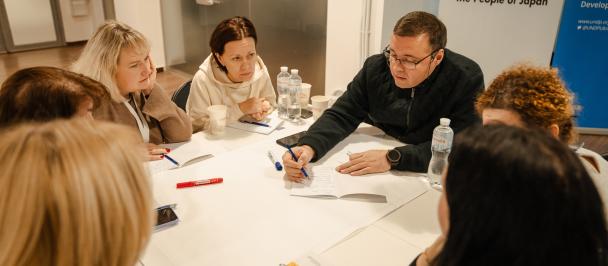From the Ground Up: Community Visions for Indonesia’s Future Capital City
September 8, 2024

“Monkeys and other wildlife started to occupy the roads. We should conserve and provide their needs to foster sustainable wildlife.” – village resident
“Animals have their own habitat and are protected by the government. Residents also deserve to be prioritized and taken care of by the government.” – village resident
These insights, shared during a workshop with local communities, highlights the aspirations of the residents of East Kalimantan, the site of Indonesia’s new capital city, Nusantara. Pemaluan Subdistrict, one of the 13 village-level areas within Nusantara’s boundaries, represents a crucial voice in this transformative project. As the city evolves from concept to reality, understanding these community-driven perspectives is essential. Building a new city is about more than infrastructure; it's about adapting lives, identities, and cultural values.
Understanding the Scale of Transformation
The transition of Nusantara from rural villages to the national capital is not just a physical shift—it’s a profound adaptation of social identities and economic practices. Moving from an agrarian lifestyle to a high-tech urban environment requires reimagining how communities view themselves and their roles within the nation.
Following an MoU signed between UNDP and the Nusantara Capital City Authority (OIKN), UNDP Indonesia Accelerator Lab Indonesia collaborated with OIKN, National Research and Innovation Agency (BRIN), and Kota Kita Foundation to strengthen Nusantara’s “Inclusive Forest City” concept through a participatory planning process. The team sought to collectively explore how foresight could aid governments in navigating uncertainties and preparing for future challenges. Careful planning that incorporates local needs and aspirations can ensure that Nusantara becomes a symbol of national progress that honors and uplifts its residents.
Gathering Community Insights
Figure 1. Participatory methods to gain local communities’ insights
Source: UNDP and Kota Kita (2023)
To capture the perspectives of local communities, a range of field activities was conducted. These included:
Stakeholder Interviews: Engaging with key local government officials and community leaders to understand their views on Nusantara’s development and their desired roles in the planning process.
Transect Walk: A guided walk with residents to map key landmarks, infrastructure, and community assets, which helped build trust and set the stage for deeper discussions.
Participatory Workshop: Bringing together 26 participants, including local leaders, indigenous people, and representatives of vulnerable groups, to share their experiences and aspirations for future public spaces.
Field Observation: Assessing broader social and spatial conditions, including the impact of Nusantara’s development on villages, provided a comparative view of how the new capital is affecting different communities.
Insights from the Community
The workshops revealed key insights that reflect the priorities of East Kalimantan residents as they face the monumental shift brought by Nusantara’s development.
Active Lifestyle and Community Bonding
Some residents emphasized the importance of spaces that support an active lifestyle. Public areas equipped with sports and recreation facilities are crucial for maintaining the strong sense of community that defines life in these villages. Sports, particularly volleyball, are integral to social cohesion, allowing for intergenerational interaction and strengthening community bonds. The transformation of Nusantara must include spaces where these vital social practices can continue and flourish.
Fostering Interaction and Belonging
Another resident highlighted the need for public spaces that facilitate interaction and intimacy. The new capital should provide environments that nurture traditional games and social practices that have historically brought people together. Modernization should enhance, not erase, the cultural fabric that binds them. The community’s close connection to their land and each other makes them keenly aware of what is at stake—both in preserving their cultural identity and in creating spaces where new memories can be forged.
Cultural Preservation as a Cornerstone
Another significant point conveyed by residents underscored the necessity of integrating cultural preservation into the new urban landscape. The Adat Paser, for instance, is not just a set of customs but a living tradition that must be visibly and tangibly maintained within Nusantara. This preservation is crucial, not just for cultural continuity but as a statement of identity for the indigenous communities who have long called this region home.
Balancing Human and Environmental Needs
Discussions around Nusantara’s development have also highlighted the delicate balance between human development and environmental conservation. Notably, one resident expressed concerns about the need to protect wildlife while ensuring that the rights and needs of local people are not overshadowed. These communities, being closest to the issues, possess the insight and agency necessary to advocate for solutions that are both innovative and grounded in local realities.
Empowerment through Participation
A recurring theme was the community's desire for meaningful involvement in the development process. The residents of East Kalimantan are deeply connected to their land and culture and seek to be active participants in shaping Nusantara. Their insights provide invaluable perspectives that can guide development in ways that honor their heritage while embracing the future.

Figure 2. Desired Activities in the Future Public Space of Nusantara


Figure 3. Envisaged facilities within public parks in Nusantara
Bridging Community Aspirations with Government Plans
These community insights offer valuable perspectives that can complement the government's vision for Nusantara.

Figure 4. Creative and forward-looking tools were used to reimagine the future of public space
Towards a Collective Future
As we continue to gather and analyze these community insights, the next step is clear: facilitating a balanced dialogue between the government and local communities. This dialogue is crucial in identifying entry points for a collective vision of Nusantara—a vision that honors both the aspirations of its residents and the ambitious goals of the nation.
Stay tuned as we explore these conversations and move closer to realizing a new capital city that truly embodies the spirit of Indonesia.
Contributors:
Aisha Marzuki (Strategic Learning and Visual Designer, UNDP Bangkok Regional Hub)
Daniel Dyonisius (Head of Solutions Mapping, UNDP Accelerator Lab Indonesia)
Indrajit Joyosumarto (R&D Officer, UNDP Accelerator Lab Indonesia)
Hasanatun Nisa Thamrin (Program Manager, Kota Kita Foundation)
Asri Septarizky (Program Officer, Kota Kita Foundation)

 Locations
Locations







